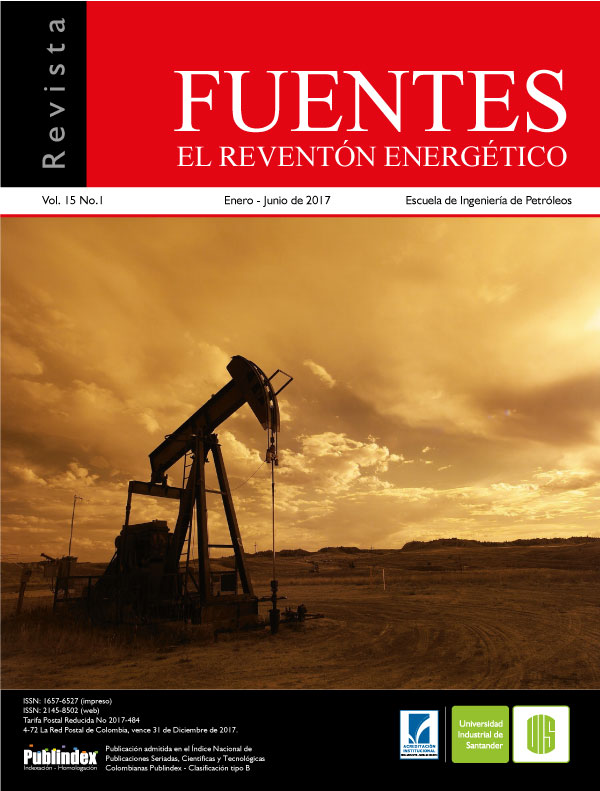Establishment of an additional value of HCDP in the warm Colombian zone
Published 2017-06-01
How to Cite
Abstract
The content of small amounts of water and condensate in the natural gas generate problems in transport lines, cause corrosion and other damage in compression equipment or turbines. That is why natural gas must be submitted to various treatments to meet established quality specifications; between the quality parameters is the Hydrocarbon Dew Point (HCDP), which indicates the minimum temperature at which gas can be submitted without condensed, to set this parameter, it is necessary to consider thermodynamic, climate and regulatory criteria. However, not all HCDP regulations are equal; therefore, a gas that is transported in the pipeline system of a country may not be suitable for the network in another country. Given the above, this article presents the establishment of a possible additional value hydrocarbon dew point for the warm area of Colombia, performing a hydraulic simulation in dynamic state, which provides for inclusion of the temperature profile and the relief flowing through the pipeline.
Keywords: HCDP, Condensate, Hydrocarbon dew Point, Natural Gas.
Downloads
References
- Acer – Agency for the Cooperation of Energy Regulators. (2011). Framework Guidelines on Interoperability Rules for European Gas Transmission Networks.
- Alemania. (2013). GRTgaz. Gas Specification.
- Argentina. Ente Nacional Regulador del Gas ENARGAS. (2005). Ley24.076. Reglamentación de las Especificaciones de Calidad de Gas Natural. Buenos Aires.
- Belgica. (2004). Energy Charter Secretariat. LNG and Natural Gas Quality Standards.
- Bolivia. Superintendencia de Hidrocarburos. (2007). Resolución Administrativa No. 0433/2007. Términos y Condiciones Generales de Servicio de Gas Transboliviano. La Paz.
- BP. International Gas Union. (2011). Guidebook to Gas Interchangeability and Gas Quality.
- Brasil. Agencia Nacional del Petróleo – ANP. (2002). Ordenanza No. 104 de 2002. Establece las Especificaciones del gas natural, de origen nacional o importado, que se comercialicen en el país. Estatus: Derogada.
- Brasil. (2008). Agencia Nacional del Petróleo – ANP. Resolución No. 16 de 2008. Establece las Especificaciones del gas natural, de origen nacional o importado, que se comercialicen en el país. Estatus: Actual.
- Canadá. (2013). TransCanada. Gas Quality Specifications.
- Canadá. (2006). TransGas. Standard Natural Gas Specifications.
- Ecuador. (2009). Instituto Ecuatoriano de Normalización. Norma Técnica Ecuatoriana NTE INEN 2 489:2009. Gas Natural. Requisitos. Quito.
- España. (2011). Enagas. Gestión Tecnica del Sistema. Calidad del Gas.
- Great Southern Press. Australia. Recuperado de: https://www.gs-press.com.au/#. Consultado el: 05 de noviembre de 2013.
- Great Australian Pipeline Industry Association. Australia. Recuperado de: http://www.apga.org.au/. Consultado el: 05 de noviembre de 2013.
- Irlanda. (2008). Bord Gais Nestworks. Report on Gas Quality Arrangements in Republic of Ireland.
- Lituania. (2012). Lithuanian Energy Institute. Natural Gas Quality Changes Analysis and Estimation of Transmission System Values.
- Marcogaz. (2003). 1ST Position Paper on European Gas Quality Specifications. Gas Quality. UTIL-03-06. 18. Marcogaz. National Situations Regarding Gas Quality. UTIL-GQ-02-19. 2002.
- Mexico. (2010). Comisión Reguladora de Energía. Secretaría de Energía. Norma Oficial Mexicana NOM-001-SECRE-2010. Especificaciones del Gas Natural. Mexico D. F.
- Mapa Red Nacional de Gasoductos: Gasoducto Ballena –Barrancabermeja. Transportadora de Gas Natural Internacional – TGI S.A. E.S.P. www.tgi.com.co.
- Peña, H., Santos, N. y Pérez, J. (2004). Estudio experimental, caracterización composicional detallada, ajuste de la ecuación de estado y generación de las envolventes de fase de las corrientes de carga a los gasoductos Centragas y Promigas. Universidad Industrial de Santander (UIS). Bucaramanga, Santander (Colombia).
- Nueva Zelanda. Gas Industry Company Limited. Recommendation to the Minister of Energy bythe Gas Industry Co. on the Specification for Reticulated Natural Gas.
- Nueva Zelanda. (1999). National Regulation. NZS 5442:1999.
- Poyry. (2011). GL Noble Denton. Study on Interoperability - Gas Quality Harmonisation – Cost Benefir Analysis.
- Rusia. (2008). Gazprom Export. Storage Specification. Moscow.
- United Kingdom. (2013). Interconnector. Guide to Gas Quality Requirements.
- United Kingdom. (2013). Premier Transmission Limited. Transportation Code.
- USA. (2004). The University of Center For Energy Economics. Interstate Natural Gas – Quality Specifications and Interchangeability. Austin.
